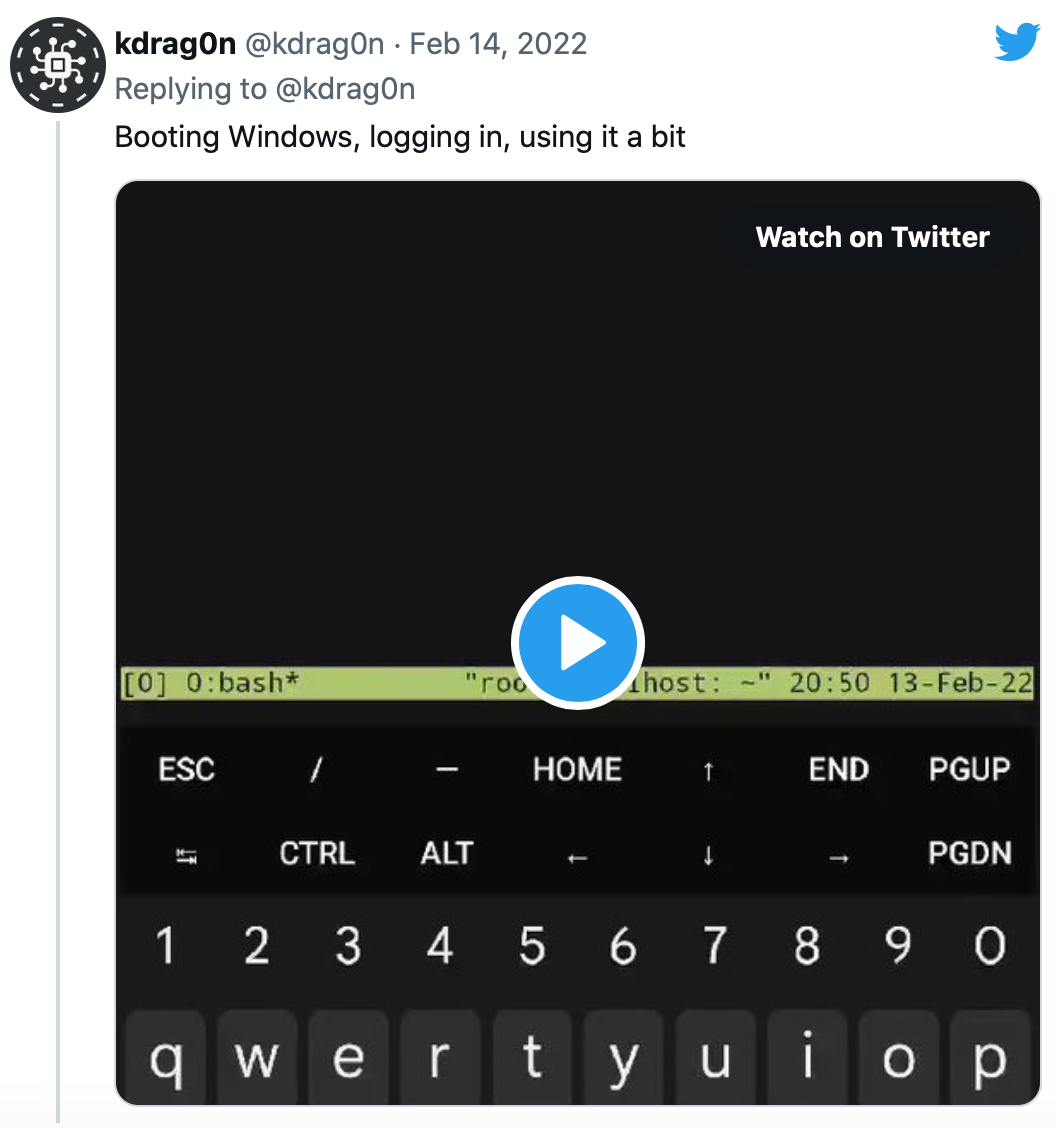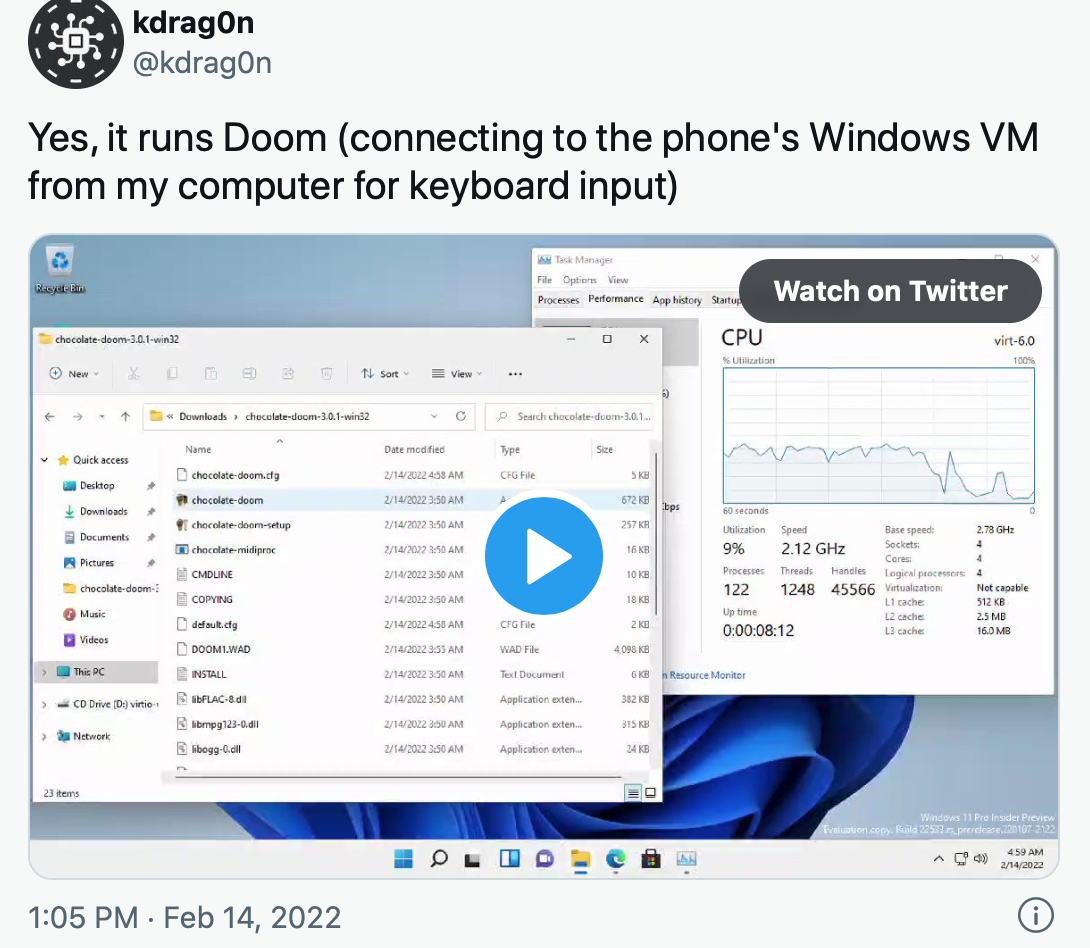Although the new Android 13 developer preview released a few days ago was a little disappointed by many people, some developers recently discovered an "easter egg" hidden by Google in Android 13 - the developer installed on Google Pixel 6 devices After Android 13, full virtualization is possible.
According to foreign media reports such as Ars Technica, an Android&web developer named kdrag0n earlier found an interesting new feature in Android 13: support for virtualization!
This means that it is now possible to run almost any OS on the Pixel 6 (or other Tensor processor-driven devices, including ARM Windows 11, desktop versions of Linux such as Ubuntu or Arch Linux Arm, and running at near-native speeds) .
On February 14, developer kdrag0n tweeted a video about the news, revealing that he had commandeered the "Easter Egg" feature to boot ARM Windows 11 and desktop Linux. In the video, kdrag0n even runs the Doom game for Windows in a virtual machine on the Pixel 6.
It is reported that kdrag0n has tested several Linux distributions compiled for Aarch64 with Ubuntu 21.10, Arch Linux Arm, Void Linux and Alpine Linux on Pixel 6 phones via "KVM hypervisor on Pixel 6 + Android 13 DP1" .
Android 13 has "full KVM capabilities" with "near native performance" and requires root to enable features that don't support GPU acceleration, kdrag0n said. Since that feature also doesn't support nested virtualization, it's impossible to make an infinitely nested OS turducken, although it's now possible to run Android on Windows and Windows on Android.
It is understood that Google has been building virtualization in Android for its own reasons. As early as a few years ago, there were rumors that "Google is developing Android specifically for virtualization". The outside world is still unknown. The operation of Android developer kdrag0n this time has also inspired netizens who are concerned about this news.
Although for a neat demo like kdrag0n, some media commented that this is nothing like what Google wants to do with Android's upcoming virtual machine support.
It has been observed that the virtualization process of Google's Android system seems to intend (and possibly in Android 13) to use the virtual machine as a security and privacy sandbox for various functions. Earlier media reported that "Google is adopting Linux kernel KVM and Chrome OS's hypervisor crosvm", and there are reports that the company is also building a stripped-down version of the Android operating system -- "Microdroid" that runs on a virtual machine, hoping to get rid of ARM's TrustZone (running DRM or something) and encryption works.
With the Android system's virtualization program, it is possible to run both Android and protected KVM on the phone hypervisor. This way, sensitive data does not need to be handled at the normal application privilege level, because the data is handled in a separate operating system, so any attacker who wants to "break" must first break through the application security model, and then Android, then a hypervisor, then another private operating system, which allows for a higher level of privacy and security for virtual machine data.
Of course, the above speculation about Google's virtualization plans seems too far-fetched, but at the moment, the first part of Google's virtualization efforts seems to be standardizing the Linux kernel that ships with Android devices. "Bloated" kernels on Android systems have been the subject of much-discussed users these days, and every phone comes with a custom version of the Linux kernel loaded with specific changes and drivers. The kernel is basically never updated, and when there are over 10,000 different Android kernels, it's hard to roll out any virtualization features at the OS level. As such, it was previously reported that Google's plan to standardize the Linux kernel was dubbed "GKI" or "Generic Kernel Image."
Since the common kernel is the Android kernel with as few changes as possible, any manufacturer changes or hardware support is done through the module system. The main kernel is now standardized and has a known set of functions. And GKI was the first to launch the Pixel 6 device, which is why the Pixel 6 was the first (and so far the only) Android phone kdrag0n discovered to be capable of "virtualization."





**粗体** _斜体_ [链接](http://example.com) `代码` - 列表 > 引用。你还可以使用@来通知其他用户。